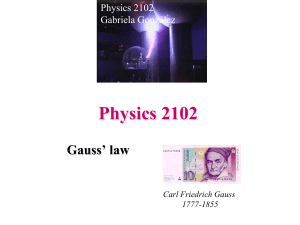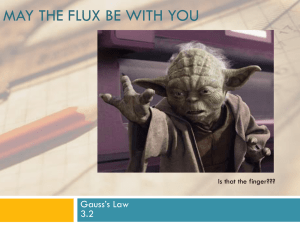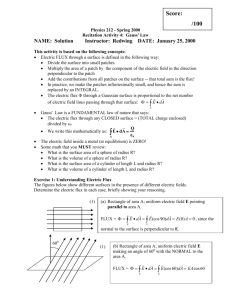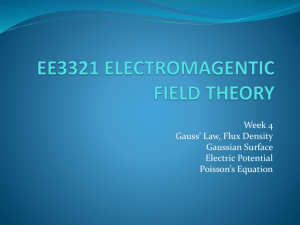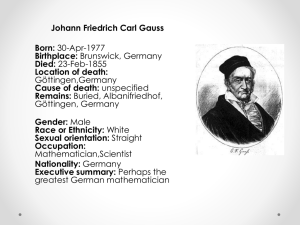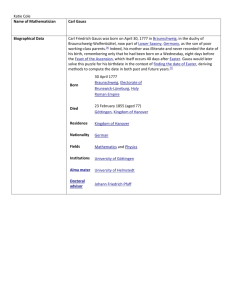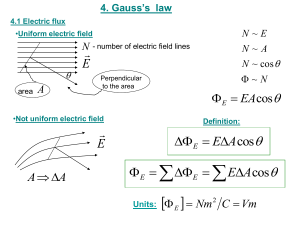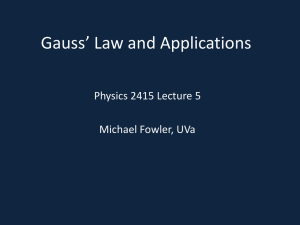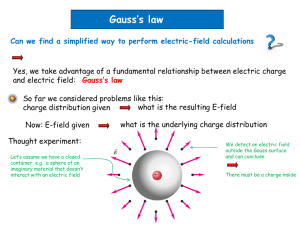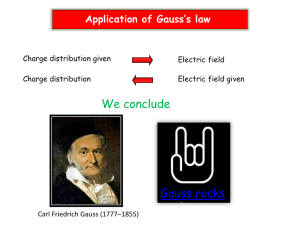Gauss` law
advertisement
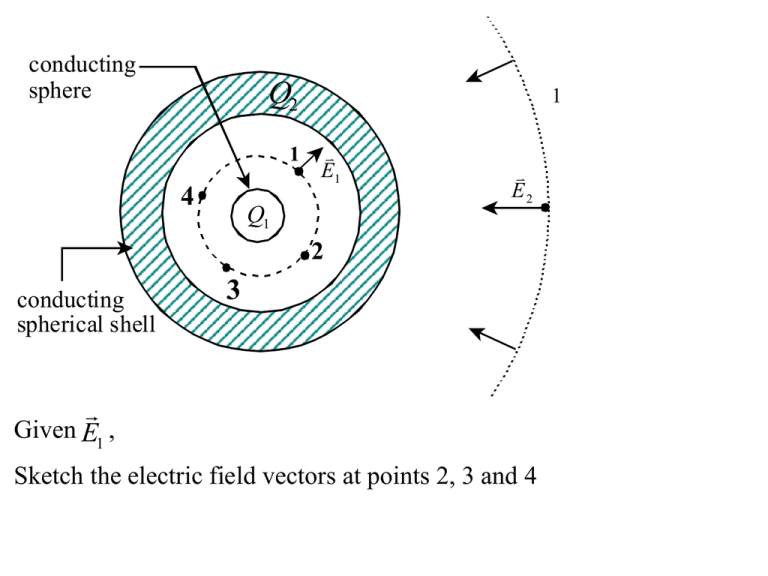
conducting sphere Q2 1 4 1 E1 E2 Q1 2 conducting spherical shell 3 Given E1 , Sketch the electric field vectors at points 2, 3 and 4 Ne is the electric flux through the closed surfaces below, and + and represent equal but opposite charges: Ne = (no. of outgoing field lines) - (no. of ingoing field lines) Which of the following are true? 1. + + - (a) Ne > 0 (b) Ne < 0 (c) Ne = 0 + + + 3. (a) Ne > 0 (b) Ne < 0 (c) Ne = 0 +2. (a) Ne > 0 (b) Ne < 0 (c) Ne = 0 + + +- 4. (a) N e > 0 (b) N e < 0 (c) N e = 0 conducting sphere Q2 1 4 1 E1 Q1 2 conducting spherical shell 3 E2 5 Recall Gauss’ law qinside Eni Ai i Considering the spherical “Gauss surface” through points 1, 2, 3, 4, Is Q1 : a) zero b) +ve c) –ve? Considering the spherical “Gauss surface” through point 5, Is Q2 : a) zero b) +ve c) –ve? (No calculation needed.) o conducting sphere Q2 1 4 1 E1 E2 Q1 Recall Gauss’ law qinside Eni Ai 2 conducting spherical shell 3 i o Considering that E=0 inside the shell material, is the charge on the inside surface of the shell: a) zero b) - Q1 d) - Q2 e) Q2 - Q1 c) Q2 Hint: Draw a Gauss surface inside the shell material. E Ex area A y x z What is the electric flux Φe through the area A ? a) E b) EA c) Ax d) None of the above E Ex area A y x z What is the flux through area A ? a) EA b) EA sin 2 c) EA cos 2 d) none of the above The conducting plate below carries a charge -Q. For the Gauss surface shown, which is the correct value of the electric flux e through the Gauss surface? A2 A4 A1 A3 Gauss A6 surface A 5 Hints: (1) Draw field lines from the plate (2) e E ni Ai i (a) e = (A1 + 2A2 + 2A3 + 2A4 + 2A5 + A6 ) x E (b) e = A1 x 0 + 2A2 x 0 + 2A3 x 0 + (2A4 + 2A5 + A6 ) x E (c) e =A1 x 0 + 2A2 x 0 + 2A3 x 0 + 2A4 x 0 (d) Zero + 2A5 x 0 + A6 x E The conducting sphere below carries a charge -Q. What is the value of the electric flux e through the concentric spherical Gauss surface with radius r? -Q r Note: F ke Q Q 1 where ke , (Coulomb's law) 2 r 4 o F qE , e E ni Ai i (a) e Q o (c) e Q 4 o r 2 (e) e Q o (b) e Q o (d) e Q r 2 Conducting sphere Gauss surface E = 106 N/C at point P, 0.25 m from the centre of the long charged wire. What is the charge q in a length l = 0.10 m of the wire? (a) q o r 2 E E Ez 106 (b) q o r lE 2 (c) q o (2 r 2 2 rl ) E (d) q 2 o rlE P 12 2 C /Nm N C z r = 0.25m z l where o 8.854 10 y x 2 Hints: - Use Gauss' law to determine Q if you know E. First, sketch field lines. Choose Gauss surface so En = constant everywhere on it. Field at r from spherical charge q. Gauss' law says: Total outgoing flux e Eni Ai i qinside 0 For the spherical charge below, 1. Sketch the form of the electric field lines, with an arrow to show direction. 2. Choose a Gauss surface which is where you want to calculate the electric field and its shape is such that EE = constant everywhere on it. 3. Determine the normal component of E on this surface (En) 4. Divide the surface into bits of area )A. What is the value of En)A on one of these bits? 5. What is the sum of all the En)A? 6. From Gauss' law, what is the value of E at the distance r from the centre of the spherical charge? q
